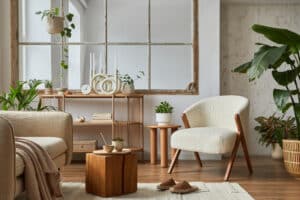Written by the NDA Dubai team
For many around the world, the city of Dubai and the United Arab Emirates instantly conjure up images of towering skyscrapers, ultra-modern malls and futuristic designs. But a closer look shows a design aesthetic that is rooted in tradition a lot more than it appears at first. As the country rapidly grows and develops, its local talent is making a conscious effort to hold on tighter to its heritage and character and make room for them within a modern context.
Over the past few years, there’s been greater focus on drawing inspiration from the country’s natural environment, Bedouin culture and preserving a long history of craftsmanship. Designers like Khalid Shafar and Aljoud Lootah have made a name for themselves for celebrating traditional crafts and seamlessly incorporating them into high-end contemporary design.
Walking through Index Dubai 2019 this week, the country’s main interior design exhibition, we spotted some wonderful examples of modern designs that celebrate local culture and artisanal work. This was especially evident at the exhibition area of arts and design group ‘Tashkeel’ and its incubator program ‘Tanween’, that support emerging designers with a cultural interest.
Here’s a look at 10 examples from Index that blend past and present in interior design:
Moza chair – by Studio Muju
A top-selling piece at Tashkeel, this chair mixes the warm colours of traditional Sadu tapestry woven by local craftswomen with a bright pop of yellow for a modern look. Its high back is reminiscent of a traditional Sadu loom.


San’am rug – by Zeinab Al Hashemi
Literally meaning ‘camel hump’, this rug is made with camel leather and filled with sand and can either be laid flat or shaped into slopes and troughs that resemble desert sand-dunes.

Thubaabah decorative piece – by Latifa Saeed
This is a quirky decorative piece that consists of a spinning fly made with palm leaves that floats magnetically above a woven ‘khoos’ rug, traditionally used for eating.


Forma Two stool – by Rand AbdulJabbar
Designed to shed light on the dwindling art of fishing-boat building (known as dhows), this stool’s design is inspired by the form of the dhow and manufactured by local boat builders.

Dhadh children’s seat – by Lujain Abulfaraj
Created to help children learn the Arabic alphabet in a fun and interactive way, this colourful modular seat can be reshaped into a number of different letters, successfully blending the roles of furniture and learning toy.


Link coffee table – by Renad Hussein
No ordinary coffee table, Link is designed to be a focal point within a modern ‘majlis’ (communal meeting place): a marble tub, filled with desert sand, with lighting controlled by a phone app, and a stylus that allows you to create patterns on the sand for a real interactive experience.


Host Lamp – by Alya Ehgfeli
Arabic coffee is a symbol of hospitality all over the Middle East, and what better way to showcase the Bedouin tradition of hosting passers-by in the desert than through a lamp incorporating coffee granules in its design?


Coral Sun series – by Zuleika Penniman
Coral as room dividers? Not so unusual in the UAE, where coral from local reefs was used to create privacy long before gypsum board was introduced to the region. Built with coral repurposed from tearing down old local houses, this material has found new life in the form of a modern screen.

Zea table lamp – by Hamza Omari
A tribute to the desert sand and its movement, this lamp consists of a wheel that can be turned, with the sand inside shifting and flowing, and changing the light as it covers the light source inside the tube.


Insight Out – by Myrtille Ronteix
The woven palm leaf texture at the center of this lamp as well as a horse-hair tassel suspended from the bottom, add warmth and interest to its sleek and minimalistic cylindrical form.

These were just some of the impressive creations supported by Tashkeel and showcased at the exhibition, that demonstrate how an appreciation for tradition and craftsmanship combined with a fresh perspective, can help keep a region’s heritage and culture alive well into its future.

